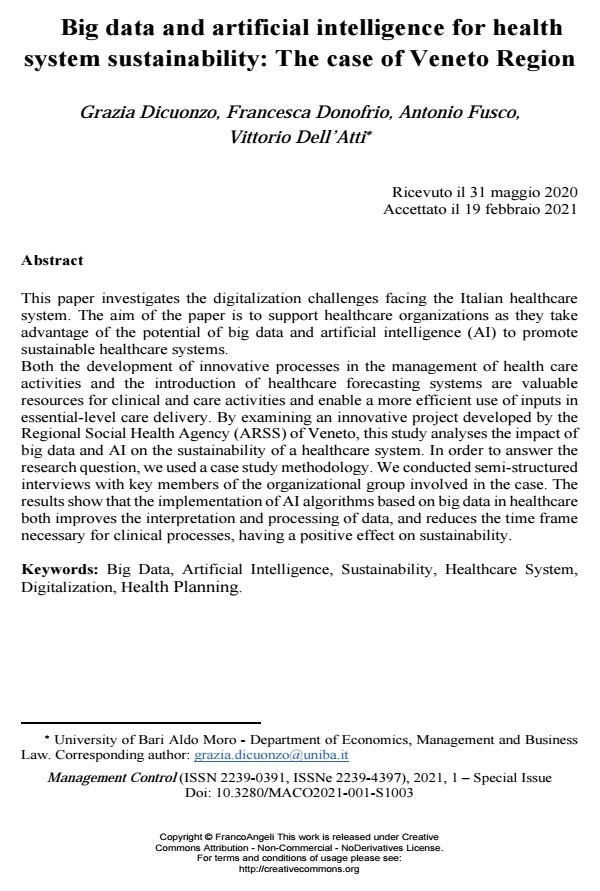Big data and artificial intelligence for health system sustainability: The case of Veneto Region
Journal title MANAGEMENT CONTROL
Author/s Grazia Dicuonzo, Francesca Donofrio, Antonio Fusco, Vittorio Dell’Atti
Publishing Year 2021 Issue 2021/suppl. 1
Language English Pages 22 P. 31-52 File size 260 KB
DOI 10.3280/MACO2021-001-S1003
DOI is like a bar code for intellectual property: to have more infomation
click here

FrancoAngeli is member of Publishers International Linking Association, Inc (PILA), a not-for-profit association which run the CrossRef service enabling links to and from online scholarly content.
This paper investigates the digitalization challenges facing the Italian healthcare system. The aim of the paper is to support healthcare organizations as they take advantage of the potential of big data and artificial intelligence (AI) to promote sustainable healthcare systems. Both the development of innovative processes in the management of health care activities and the introduction of healthcare forecasting systems are valuable resources for clinical and care activities and enable a more efficient use of inputs in essential-level care delivery. By examining an innovative project developed by the Regional Social Health Agency (ARSS) of Veneto, this study analyses the impact of big data and AI on the sustainability of a healthcare system. In order to answer the research question, we used a case study methodology. We conducted semi-structured interviews with key members of the organizational group involved in the case. The results show that the implementation of AI algorithms based on big data in healthcare both improves the interpretation and processing of data, and reduces the time frame necessary for clinical processes, having a positive effect on sustainability.
Keywords: Big Data, Artificial Intelligence, Sustainability, Healthcare System, Digitalization, Health Planning.
- Leveraging artificial intelligence to advance implementation science: potential opportunities and cautions Katy E. Trinkley, Ruopeng An, Anna M. Maw, Russell E. Glasgow, Ross C. Brownson, in Implementation Science 17/2024
DOI: 10.1186/s13012-024-01346-y - Exploring the Impact of Digitalization on the Social Economy: A Systematic Literature Review Sara Damavandi, Laura Berardi, in MANAGEMENT CONTROL 3/2024 pp.61
DOI: 10.3280/MACO2024-003004 - Opportunities and risks in using big data to support management control systems: A multiple case study Francesco Badia, Fabio Donato, in MANAGEMENT CONTROL 3/2022 pp.39
DOI: 10.3280/MACO2022-003003 - Gestione integrata dei dati e performance aziendali Antonella Paolini, in MANAGEMENT CONTROL 2/2022 pp.5
DOI: 10.3280/MACO2022-002001 - Towards the Use of Big Data in Healthcare: A Literature Review Grazia Dicuonzo, Graziana Galeone, Matilda Shini, Antonella Massari, in Healthcare /2022 pp.1232
DOI: 10.3390/healthcare10071232 - Machine Learning for Disease Detection, Prediction, and Diagnosis Vijayetta Sharma, pp.335 (ISBN:978-981-96-4240-3)
- Sustainability certifications as enablers of intellectual capital and digital transformation in SMEs Veronica Procacci, Martina Manzo, Tommaso Beck, Francesco Manca, in VINE Journal of Information and Knowledge Management Systems /2025 pp.1
DOI: 10.1108/VJIKMS-07-2025-0304 - Utilization of GeoAI Applications in the Health Sector: A Review Anastasia Amponsah, Philia Latue, Heinrich Rakuasa, in Journal of Health Science and Medical Therapy /2023 pp.49
DOI: 10.59653/jhsmt.v1i02.240
Grazia Dicuonzo, Francesca Donofrio, Antonio Fusco, Vittorio Dell’Atti, Big data and artificial intelligence for health system sustainability: The case of Veneto Region in "MANAGEMENT CONTROL" suppl. 1/2021, pp 31-52, DOI: 10.3280/MACO2021-001-S1003